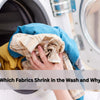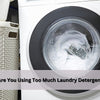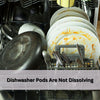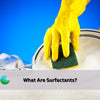Washing Cloth Diapers: The Parent's Guide
- by Brodie Cook

Using cloth diapers is a great way to help the environment and save money. They're softer on your baby's skin and can even lead to earlier potty training. Plus, you'll be keeping tons of disposable diapers out of landfills.
We know washing cloth diapers might seem tricky at first. Many parents worry it's too much work or that the diapers won't get clean enough. But don't worry! With a simple routine, washing many cloth diapers is easy and hygienic. In this guide, we'll walk you through each step, from choosing the right detergent to drying methods.
Types of Cloth Diapers
There are different types of cloth diapers to choose from. Let's look at the most common ones.
Prefolds are simple cloth rectangles that you fold and secure with pins or clips. They're cheap and easy to wash.
All-in-ones are like disposable diapers but made of cloth. They're easy to use but can take longer to dry the diapers.
Pocket diapers have a waterproof cover with a pocket where you put absorbent inserts. They're popular because you can adjust how absorbent they are.
Hybrid diapers give you options. They have a reusable cover that you can use with cloth inserts or disposable inserts. This is handy when you're travelling or if you want to mix cloth and disposable diapering.
Consider your lifestyle when selecting diapers for your baby. Each type has its pros and cons, so you might also want to try a few to see what works best for you and your baby.
Essential Supplies
To wash cloth diapers, you'll need a few key items. First, you'll want a diaper pail or wet diaper bag to store dirty wet diapers into the pail until wash day. These help keep smells contained and make it easy to carry diapers to the washer.
Next, you'll need a cloth diaper-safe laundry detergent. Regular detergents can cause buildup on diapers, making them less absorbent. Look for detergents without fabric softeners, fragrances, or optical brighteners. Try Lucent Globe laundry detergent sheets for a perfect solution! These sheets are free from harsh chemicals and ideal for cloth diapers.
A diaper sprayer can be helpful but isn't a must-have. It attaches to your toilet and makes rinsing poop off diapers easier. If you don't have one, you can use the swish method in the toilet. Other useful items include dryer balls or dryer sheets to help diapers dry faster and a scoop of baking soda to control odours in your diaper pail.
The Washing Process
Washing cloth diapers is easy once you get the hang of it. Here's how to do it step by step:
First, prepare your diapers for washing. If your baby is only breastfed, you can put dirty diapers straight into the wash. Breastfed poop is water-soluble. For babies on formula or solid foods, you need to remove poop first. Shake it into the toilet or use a diaper sprayer to rinse it off.
Now, let's go through the step-by-step guide washing routine:
- Start with a cold rinse cycle. This helps remove stains and leftover poop.
- Next, do a hot or warm water wash cycle with cloth diaper-safe laundry detergent. Use about half the amount you'd use for regular clothes. if you use Modern washing machines, they often have special cycles for delicate items like a baby's diaper or other baby clothes
- Finish with an extra rinse cycle to make sure all the soap is gone.

For drying, the best method for drying cloth you have two main options. You can hang diapers outside to dry. Sunlight is great for removing stains and killing germs. Or you can use a dryer on low heat. Be careful with high heat, as it can damage the waterproof parts of some diapers. Many parents find that a combination of methods is the best method for drying cloth diapers, but don't forget to always check the care instructions for your specific diapers.
Special Considerations When Cleaning Reusable Diapers
When washing cloth diapers, there are a few special things to keep in mind:
Water is key and hard water minerals can make cleaning tougher. If you have hard water, you might need to use more detergent or add a water softener. You may also need to do extra rinses to remove all the soap.
Dealing with odours and stains can be tricky. For stubborn smells, try adding a bit of vinegar to the rinse cycle. But don't use it too often, as it can harm some diaper materials. For stains, sunlight is your best friend. Hang stained diapers in the sun for a natural bleaching effect.
Avoid using fabric softeners and chlorine bleach. These can coat the diaper fibres, making them less absorbent. They can also irritate your baby's skin. Instead, use dryer balls if you want softer diapers. If you need to disinfect, use non-chlorine bleach or try sunning the diapers.
Remember, every diaper and every baby is different. You might need to adjust your routine to find what works best for you.
Establishing a Routine

Knowing how often to change your baby's cloth diapers is important for their comfort and health. Newborns typically need the most diaper changes, often 10-12 times a day or every 2-3 hours. As your baby grows, you might do 8-10 diaper changes per day. By the time they're a few months old, you may be down to 6-8 changes daily. Always change diapers promptly when they're wet or soiled. This helps prevent diaper rash and keeps your baby comfortable.
Setting up a good cloth diaper washing routine is key to making it work for you. Most parents who use cloth diapers find that It's a good idea to wash every 2 to 3 days. This keeps odours under control and prevents stains from setting in. It also means you don't need a huge stash of diapers. Make sure to get the diapers stored properly between uses to prevent mildew.
When it's time to wash, aim for a load of about 12 to 18 diapers. This is the sweet spot for getting diapers clean. Too few diapers, and there's not enough friction to get them really clean. Too many, and they can't move around enough in the wash.
Try to fit diaper washing into your daily routine. Some parents like to start a load in the morning and finish it by bedtime. Others prefer to do it all at night. Find a time that works for you and stick to it. Soon, washing cloth diapers will feel as normal as any other household chore.
Common Issues
Even with a good routine, you might run into some deep problems. Here are some common issues with cloth diaper care and how to fix them:
Smelly diapers: If your clean diapers still smell bad, you might need to use more detergent or do an extra rinse. Sometimes, diapers need to be "stripped" to remove buildup. This means washing them several times without detergent.
Leaky diapers: This could mean your diapers aren't clean enough or have detergent buildup. Try using less detergent and doing an extra rinse. If that doesn't work, you might need to strip your diapers.
Rashes: If your baby gets a rash, check if you're using too much detergent. Leftover soap can irritate the skin. Also, make sure you're changing diapers often enough.
Damaged elastics or waterproofing: This usually happens from drying on high heat. Always check your diaper's care instructions. Most do best with line drying or low heat in the dryer.
Remember, it might take some trial and error to find what works best for you and your baby. Don't be afraid to ask for help from other cloth diapering parents or online communities.
Tips for Maintaining Cloth Diapers
Keeping your cloth diapers in good shape is easy with a few simple tips. First, let's talk about storing dirty diapers before you wash them. Use a diaper pail or wet bag with some airflow to prevent mould and mildew. You can add a few drops of tea tree oil or sprinkle some baking soda to control odours.
Rotating your diaper stash is a good idea. This means using all your diapers equally. It helps them wear out evenly and last longer. Also, check your diapers regularly for signs of wear and fix any small problems quickly.
Remember, Most cloth diapers are made to be durable and last through many washes. clean diapers are key to protecting your baby's skin. Wash diapers often and change your baby frequently to prevent rashes. If you notice any skin irritation, try changing your wash routine or diaper cream. With proper care, cloth diapers can keep your baby comfortable and your conscience clean!
FAQs About How to Clean Cloth Diapers
How often should you wash reusable cloth diapers?
It is recommended to wash reusable cloth diapers every two to three days to prevent odour and bacteria buildup.
What is the best method for washing cloth diapers?
The best method for washing cloth diapers is to start with a cold rinse, followed by a hot wash with a cloth diaper-safe detergent, and an extra rinse cycle.
How should you dry cloth diapers?
It is best to air-dry cloth diapers to preserve their absorbency and extend their lifespan. You can also use a dryer in a low-heat setting if necessary.
Is it necessary to use diaper liners in cloth diapers?
Diaper liners are optional, but they can make dealing with solid waste easier by catching most of it, making cleanup simpler.
How do you handle dirty cloth diapers before washing them?
After removing solid waste, store dirty cloth diapers in a diaper pail or wet bag until you are ready to wash them to prevent odours and bacteria growth.

 Dishwashing
Dishwashing Laundry
Laundry Bundles
Bundles Surfaces
Surfaces Toilet
Toilet Handsoap
Handsoap Multi-Purpose
Multi-Purpose Floor
Floor



